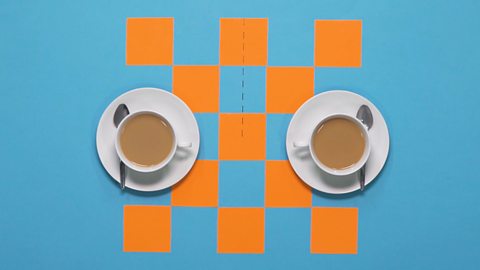Congruent shapes
congruentShapes that are the same shape and size, they are identical. means identical in shape and size.
Shapes can be congruent even if they have been rotated or reflected.
Question
Which shapes are congruent?
Answer
Shapes A, B, E and G are congruent.
Translation
To translate a shape, you can move it up or down or from side to side, but you cannot change its appearance in any other way.
When a shape is translated, each of the vertices (corners) must be moved in exactly the same way.
Translating a shape
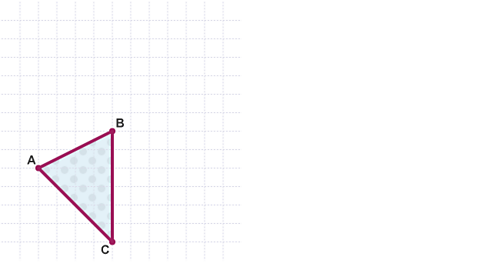
Image caption, Starting position of the shape.
Image caption, Shape is translated 5 units to the right.
Image caption, Shape is then translated 6 units up.
1 of 3
Question
Which shapes are translations of triangle A?
Answer
D and E are translations of triangle A.
Rotation
If you put a sheet of paper on a table and place your pen in the middle of it, you can rotate the paper whilst keeping the pen in a fixed position.
In doing this, you are rotating the paper about its centre, defined by the position of the pen.
Rotating from centre
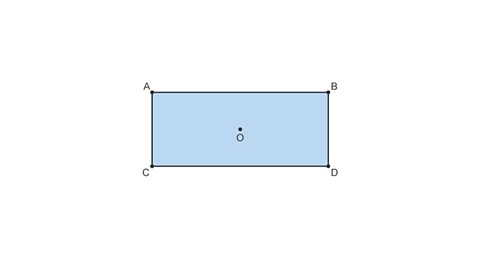
Image caption, Static sheet of paper with no rotation.
Image caption, 90 degree rotation, a quarter turn anti-clockwise.
Image caption, 180 degree rotation, a half turn anti-clockwise.
Image caption, 270 degree rotation, a three-quarter turn anti-clockwise.
Image caption, 360 degree rotation, a full turn anti-clockwise.
1 of 5
A full rotation (\({360}^\circ\)) of the sheet of paper will result in the paper being back in its original position.
In the example above, the centre of rotation was the centre of the rectangle - but what happens when the centre of rotation is outside the rectangle?
Rotating from a centre outside the shape
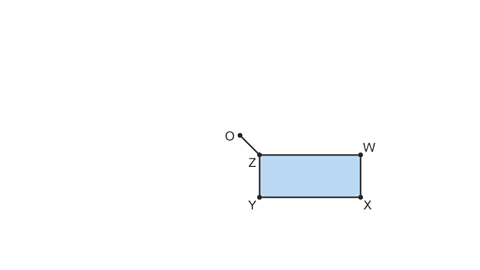
Image caption, A rectangle with a point of rotation outside the shape.
Image caption, A quarter turn, 90 degrees anti-clockwise.
Image caption, A half turn, 180 degrees anti-clockwise.
Image caption, A three-quarter turn, 270 degrees anti-clockwise.
Image caption, A full turn, 360 degrees anti-clockwise.
1 of 5
Reflection
If you look in a mirror, you see your own image. You (the object) and your image appear to be the same distance from the mirror.
An object and its image are always the same perpendicular distance from the mirror line.
(Perpendicular means 'at right-angles to'.)
Look at the following examples:
Each point and its image are the same distance from the mirror line.
Finding reflections using tracing paper
Sometimes the mirror line, or line of reflection, is at an angle.

Example
Reflect the given shape in the diagonal line.
Use tracing paper to copy the shape and line of reflection.

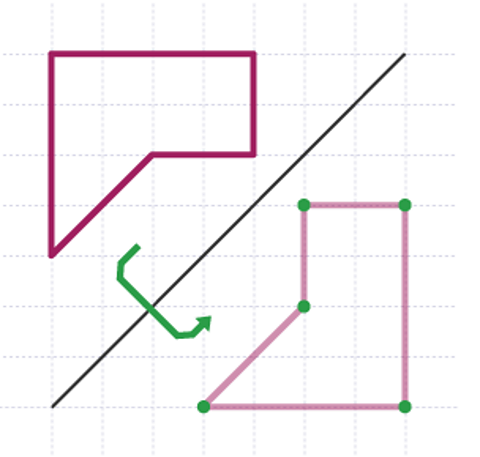
Turn the tracing paper over and match up line of reflection and the vertices.

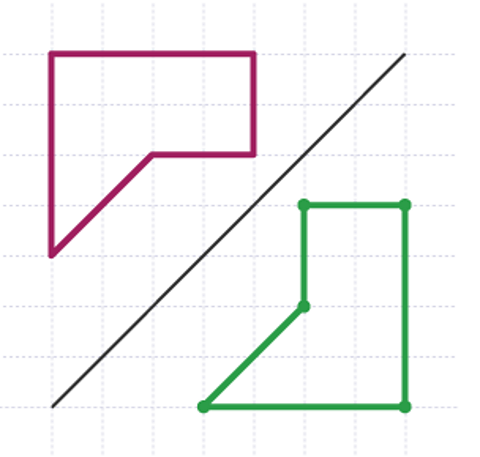
Place dots to mark the position of the vertices, then remove the tracing paper and draw the reflection of the shape.

Scale factor and enlargements
The scale factor is the number by which the length of all the sides of a shape has been multiplied to create a similar shape which is either bigger or smaller.
A scale factor of 2 means that the new shape is double the size of the original shape.
The scale factor is 2 because the length of each of the sides has been multiplied by 2.
If this is reversed:
The scale factor is \(\frac{1}{2}\) because the length of each of the sides has been divided by 2.
A scale factor of \(\frac{1}{2}\) means that the new shape is half the size of the original shape.
Example
Enlarge the shape by scale factor 3.
The base of the enlarged triangle will be \({3}\times{4} = {12~cm}\)
The height of the enlarged triangle will be \({3}\times{3}= {9~cm}\)
Question
A rectangle has length \({6~cm}\) and width \({5~cm}\).
What will be the length and width of the rectangle when it has been enlarged by a scale factor of \({2}\)?
Answer
Scale factor is \({2}\).
Enlarged length = \({2}\times{6} = {12~cm}\)
Enlarged width = \({2}\times{5} = {10~cm}\)
Example
What is the scale factor of the enlargement of the small square to the large square?
\({2.5}\times{?} = {5}\)
Answer
\({2.5}\times{2} = {5}\)
Therefore, the scale factor is \({2}\).
Question
What is the scale factor of the enlargement from triangle A to triangle B?
Answer
Base of \({A~=~2}\)
Base of \({B~=~6}\)
\({2}\times{3~=~6}\)
Height of \({A~=~3}\)
Height of \({B~=~9}\)
\({3}\times{3~=~9}\)
The base and the height have been multiplied by \({3}\) so the scale factor is \({3}\).
Example
What is the scale factor of the enlargement of shape A to shape B?
The sides in shape B are half the length of the sides in shape A.
This means that the scale factor is \(\frac{1}{2}\)
Centre of enlargement
A shape can be enlarged from a point, this point is referred to as the centre of enlargement.
To find the centre of enlargement lines are ruled from each of the vertices on the enlarged shape through the corresponding vertices on the original shape and beyond.
The point where the lines meet is the centre of enlargement.
To enlarge a shape by a scale factor from a centre point follow these steps:
Count the number of squares horizontally and vertically from the centre of enlargement to one vertex on the original shape.
Multiply these distances by the scale factor.
Go back to the centre of enlargement, count the enlarged distances in the horizontal and vertical directions and mark the vertex.
Repeat with the other vertices on the original shape to find the vertices on the enlarged shape.
Example
Enlarge this triangle by scale factor 3 from the centre marked with a GREEN dot.
Up \(1\), across \(3\).
Up \({3}\times{1}\), across \({3}\times{3}\)
Count up \(3\) and across \(9\)
Repeat with the other vertices
Test section
Question 1
The base of a triangle is \({20~cm}\).
What would the base of the triangle be after it has been enlarged by a scale factor of \({2}\)?
a) \({10~cm}\)
b) \({22~cm}\)
c) \({40~cm}\)
Answer
The correct answer is c) \({40~cm}\).
Question 2
A length of the side of a square is \({12~cm}\).
What would the length of the side of the square be after an enlargement of scale factor \(\frac{1}{2}\)?
a) \({4~cm}\)
b) \({6~cm}\)
c) \({24~cm}\)
Answer
The correct answer is b) \({6~cm}\).
Question 3
What is the scale factor of the enlargement of shape A to shape B?
a) \({3}\)
b) \({2}\)
c) \({2.5}\)
Answer
The correct answer is a) \({3}\).
Question 4
What is the scale factor of the enlargement of shape A to shape B?
a) \(\frac{1}{2}\)
b) \(\frac{1}{3}\)
c) \({3}\)
Answer
The correct answer is b) \(\frac{1}{3}\).
Question 5
Which shapes are congruent?
Answer
Shapes A, D, E and F are congruent.
Question 6
How many kinds of transformation are there?
Answer
There are \({4}\) kinds of transformation: translation, rotation, reflection and enlargement.
Question 7
Which triangles are translations of triangle A?
Answer
Translation means moving a shape. The shapes must be exactly the same size, facing the same direction and not rotated or reflected at all.
Shapes D and E are translations of Triangle A.
Question 8
How many degrees is a three-quarter turn?
Answer
A three-quarter turn is \({270}^\circ\).
Question 9
When a rectangle is rotated \({180}^\circ\) it fits perfectly over the original shape.
Where is the point of rotation?
Answer
In its centre.
A shape rotates in the same place if the point is in its centre.
Question 10
What is the name of the shape that is a reflection of the object?
Answer
The reflected shape is called the image
Question 11
Which of the following diagrams shows the correct reflection of this shape in the mirror line?
Answer
Each vertex is reflected in the mirror line, and then joined to form the reflection.
More on Shape, space and measures
Find out more by working through a topic
- count2 of 52

- count4 of 52

- count5 of 52
